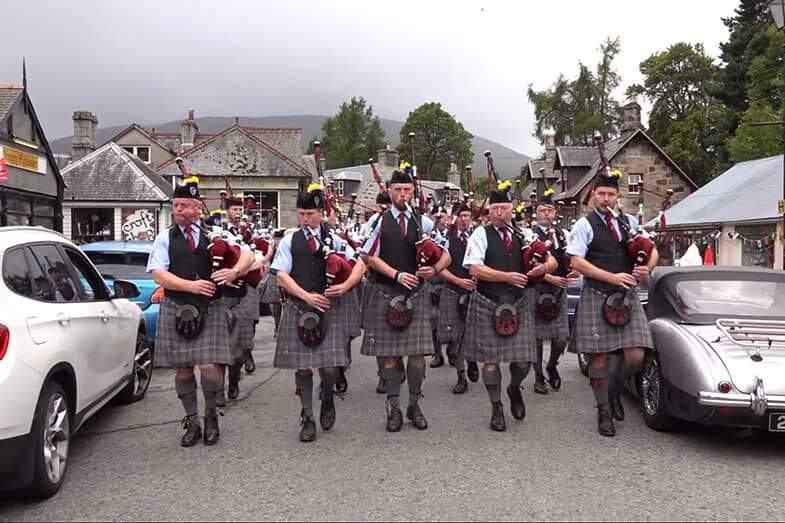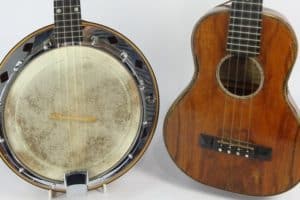Bagpipes are a fascinating instrument, from how they look to how they sound. Do you want to learn the bagpipes but aren’t sure if you want to invest the time? I’m going to answer these questions and more in this article.
How hard is it to play bagpipes, and how long to learn how to play them? Bagpipes are harder to play than many other instruments because you have to play the right notes while blowing and squeezing to keep the air flowing at the right amount. It can take about 6 to 12 months to learn simple songs and 2+ years to learn complex songs.
Read on to learn more about how hard it is to play bagpipes, also how long it takes to learn the bagpipes.
Also, we hope you find the links here useful. We may get a commission if you purchase something through a link on this page, so thank you!
Also, for an excellent Scottish bagpipe that is great for beginners, take a look at the AC Kilts Scottish Great Highland Bagpipe. Despite its affordable price, it has an impressive build quality and sound.
Click here to see it on Amazon.
To practice the pipes, you need a chanter like the RG Hardie Bagpipe Twist Trap Practice Chanter. This is an excellent practice chanter that comes with reeds and a very helpful tutor book.
Click here to see it on Amazon.
How Hard Is It to Play Bagpipes and How Long Does it Take to Learn?

There are several factors you need to know about playing the bagpipes. They include the following:
- The Air Supply
- The Steadiness of Air Supply
- How to Tune the Bagpipes
- Bagpipe Fingering
- Learning to Play Tunes
Let’s discuss each of these factors.
The Air Supply
A set of bagpipes won’t work if you don’t supply air into the bag. You’ve most likely seen how bagpipers do it — they blow air into the blowpipe.
With old bagpipes, the piper had to use his tongue to cover the tip of the blowpipe as he inhaled. Otherwise, the air would escape from the bagpipe. Can you just imagine how difficult it is to use?
This isn’t the case with modern bagpipes. Now, they feature a non-return valve. It prevents the air from escaping even without covering the tip of the blowpipe. That’s a bit easier, right?
Between the 16th and 17th centuries, inventors introduced bagpipes that featured bellows. The bellows, like the ones on an accordion, are used to supply air into the bag. That way, the piper wouldn’t have a hard time blowing air. At the same time, he wouldn’t have to cover the tip of the blowpipe as he inhaled.
Examples of bagpipes with bellows are as follows:
- Uilleann pipes from Ireland;
- Pastoral pipes from Great Britain; and
- Musette bechonnet from France; among others.
Bagpipes with bellows still exist up until now. However, some pipers find it difficult to use this type. Some still prefer directly blowing air through the blowpipe.
Both types may be hard to learn but at least there are options you can choose from. That way, you can choose whichever type you’re more comfortable with.
The Steadiness of Air Supply
It’s not enough that you only know how to blow air into the blowpipe. You must remember to also supply the right amount of air in the bagpipes in a consistent manner. Otherwise, you won’t achieve the desired sound.
When you blow into the blowpipe, the bag will stay inflated for as long as 25 seconds. While it’s inflated, you have to ensure that air is equally distributed to the chanter and drones. The bag also always has to have enough pressure. Otherwise, you won’t achieve your desired pitch. Worse, your performance will sound out of tune.
There’d be times when you’d feel like blowing air into the blowpipe in the same tempo as the music. This should be strictly avoided. Otherwise, you will ruin your performance. Doing so prevents you from distributing the right amount of air supply into the bagpipes; more so, distributing a consistent amount of air pressure. That’s why you must have the presence of mind at all times.
The same principle applies when playing the bagpipe with bellows. You must distribute a steady air supply into the different parts of the instrument. In the same manner that there must be consistent air pressure. That’s why it’s important for the arm that squeezes the bag to stay relaxed at all times.
With the bellows-blown bagpipes, be aware that your arm movement mustn’t match the music tempo. Doing so won’t provide a steady air supply and pressure.
How to Tune the Bagpipes
You have to master the art of distributing steady air supply and pressure into the bagpipes. Otherwise, you won’t be able to move onto the next stage — which is learning to tune the instrument.
Musicians automatically tune their instruments before their performances. Bagpipers are not excluded from this. They have to tune their bagpipes, especially those who use mouth-blown ones. This is due to the changes occurring with the reeds’ moisture and temperature.
The reed’s sensitivity depends on two factors — the type of bagpipes and the type of reed. With the chanter reed, you sometimes have to flatten or sharpen the reed to achieve the right notes. There are bagpipers who also apply wax to the finger holes. It’s one technique to control the notes effectively.
You might find yourself taking some time to learn how to deal with the chanter reed. In which case, don’t lose hope. You’ll most likely feel frustrated but continue to keep your patience. Before you know it, you’ve already honed your skills.
Problems with drone reeds aren’t common. But you’ll nonetheless encounter issues along the way. It’s a matter of getting to know your own instrument more as time goes by. Aim to learn how to deal with both the chanter and drone reeds. Once you do, you’re ready to tune your drone to your chanter.
If your bagpipes have several drones, then you have to tune them all. But you can’t tune them all at the same time. It must be done one by one. In doing so, you have to silence the rest of the drones while you focus on one. You may do this by covering the outlet for the drone.
Bagpipe Fingering
By now, you already know that you must fill bagpipes with air to produce sound. This also means that the sound only stops when the instrument doesn’t have any air in it. This further means that you can’t play two similar notes in a consecutive and detached manner.
That’s why bagpipers use grace notes, which they must play rapidly. Grace notes give the illusion that detached notes are being played. But pipers must be highly skilled in doing so to play it in an unnoticeable manner.
Learning to Play Bagpipe Music
Remember that once you fill the bagpipes with air, the sound will automatically start. There’s no way you can make it stop anytime you want to. So it is for this reason that you have to remember all the notes you need to play; Otherwise, your instrument will continue to make noise.
Having ‘presence of mind’ is a skill that bagpipers find challenging to master. This is because the instrument’s continuous sound distracts beginners easily.
You need plenty of practice before you start becoming comfortable playing the bagpipes. Aside from patience, you also have to preserve and be diligent. Bagpipes may be hard to learn, but you’ve got to trust the process.
Irish Bagpipes – Facts and Guide to Uilleann Pipes
This video gives some great insight on how hard it is to play the bagpipes and how long it takes to learn.
Practice Chanters for Beginners

By now, you’re aware of how hard it is to learn and play bagpipes. But if you’re nonetheless interested, then let’s talk about practice chanters.
As the term implies, the practice chanter is the bagpiper’s practice instrument. Beginners aren’t the only ones who use it. Even professionals do when they have to learn new music. They only use their bagpipes once they’ve memorized all the notes. This is because it’s quieter to use the practice chanter. There’s also lesser effort in blowing compared to when they use the full instrument. In essence, it’s more convenient to use the practice chanter to learn new music.
There are factors to consider when choosing the right practice chanter for you, such as the following:
- Your practice chanter has to be perfectly tuned. It’ll help you achieve tuneful drones, perfect volume, and impressive clarity.
- You have to make sure that your chanter has high-quality reeds. If the reeds are unstable, then it’ll affect the sound that your practice chanter produces. In which case, you need to get new reeds.
- Check if you can achieve the proper pitch without forcing the sound. If you can play it without exerting that much effort, then that’s the ideal practice chanter for you. Assess if you find it uncomfortable and uneasy to produce a strong pitch. If so, then try other practice chanters.
- The harmonic frequencies must be able to blend with the drone sound easily. You must be able to produce stable notes in a convenient manner.
- When you play your practice chanter, there must be good projection. So, you have to listen attentively to the sound that you make. Is the sound you make pleasing to the ears? Do you reach thin or full high notes? Do make loud or muffled sounds?
It’s important to consider the above-mentioned factors with your practice chanters. But more than anything else, you must be able to achieve them all so that you can easily transition to the full instrument.
Now, let’s take a look at several brands of practice chanters available on the market today. Below are some of the most recommended ones for beginners:
1. RG Hardie Bagpipe Twist Trap Practice Chanter
The RG Hardie Bagpipe Twist Trap Practice Chanter is ideal for beginners. It’s a standard practice chanter manufactured in Scotland. It comes with a chanter carry case and two high-quality reeds.
Click here to see it on Amazon.
The set includes The Highland Bagpipe Tutor Book. It features helpful links to online tutorials.
This RG Hardie Bagpipe Twist Trap Practice Chanter is a complete product offering for newbies.
2. The Frazer Warnock Standard Bagpipe Practice Chanter
Click here to see it on Amazon.
The Frazer Warnock Standard Bagpipe Practice Chanter is another great chanter to learn on. It’s a standard practice chanter manufactured in Ireland. It comes with a Barefoot Bagpiper carry case. It also features two high-quality Frazer Warnock reeds.
The practice chanter’s finger spacing is adult-sized. It’s the same size as that of the real bagpipe chanter. That way, beginners won’t have a difficult time transitioning to the full instrument.
Practice Chanter Reeds
As earlier mentioned, there’ll be instances when you have to replace your reeds. In this case, it’s important that you know the recommended reeds for practice chanters. Here are some of them:
The G1 Platinum Scottish Highland Bagpipe Chanter Reeds are perfect for beginners. There are times when a newly-purchased practice chanter produces inconsistent sound. In which case, they replace their reeds with the G1 Platinum Chanter reeds. These reeds never fail to address sound quality issues experienced by newbies.
Entry-level Bagpipes
If you are ready to get the bagpipes, I recommend the following entry-level bagpipe kit that is perfect for anyone starting out:
The AC Kilts Scottish Great Highland Bagpipe is well-made with seasoned rosewood and a beautiful golden-brass finish. There are many extras included in this kit, making it perfect for a beginner.
Click here to see it on Amazon.
The great-value AC Kilts Bagpipe comes with a 30 X 12 synthetic bag, 1 cane drone reed set, 1 synthetic drone reed set, 1 practice chanter with reed, 1 carrying hard case, 2 cane pipe chanter reeds, 1 bagpipe joint hemp, and 1 bagpipe tutor book.
Conclusion – How Hard Is It to Play Bagpipes and How Long to Learn?
So how hard is it to play bagpipes? Bagpipes are generally harder to play than many other instruments because of the multitasking involved. You need to play the right notes while squeezing the bag and blowing to keep the air flowing.
How long does it take to learn how to play the bagpipes? It takes about 6 to 12 months to learn how to correctly play some simple songs on the bagpipes. To learn more complex songs like Scotland the Brave, you will be looking at about 1 year or more to play it comfortably.
To learn how to play the bagpipes, you will need to understand the following:
- The Air Supply
- The Steadiness of Air Supply
- How to Tune the Bagpipes
- Bagpipe Fingering
- Learning to Play Tunes
Start out with a good quality practice chanter, like the ones listed above, so as to get comfortable with the notes and blowing. Or, if you have the confidence, you can jump straight to playing the bagpipes. Just get an entry-level set with a case and reeds. Remember to avoid getting overwhelmed or frustrated. Take short, regular practice sessions every day, and before you know it, you will be playing the bagpipes with ease.
Related reading:
What Are the Differences Between Irish Bagpipes and Scottish Bagpipes?
Which Wind Instrument Is Least Common in Jazz Music?













![Read more about the article How to Tune a Banjo? [5-String and 4-String Banjo Tuning]](https://musicalinstrumentpro.com/wp-content/uploads/2021/01/how-to-tune-a-banjo-300x200.jpg)